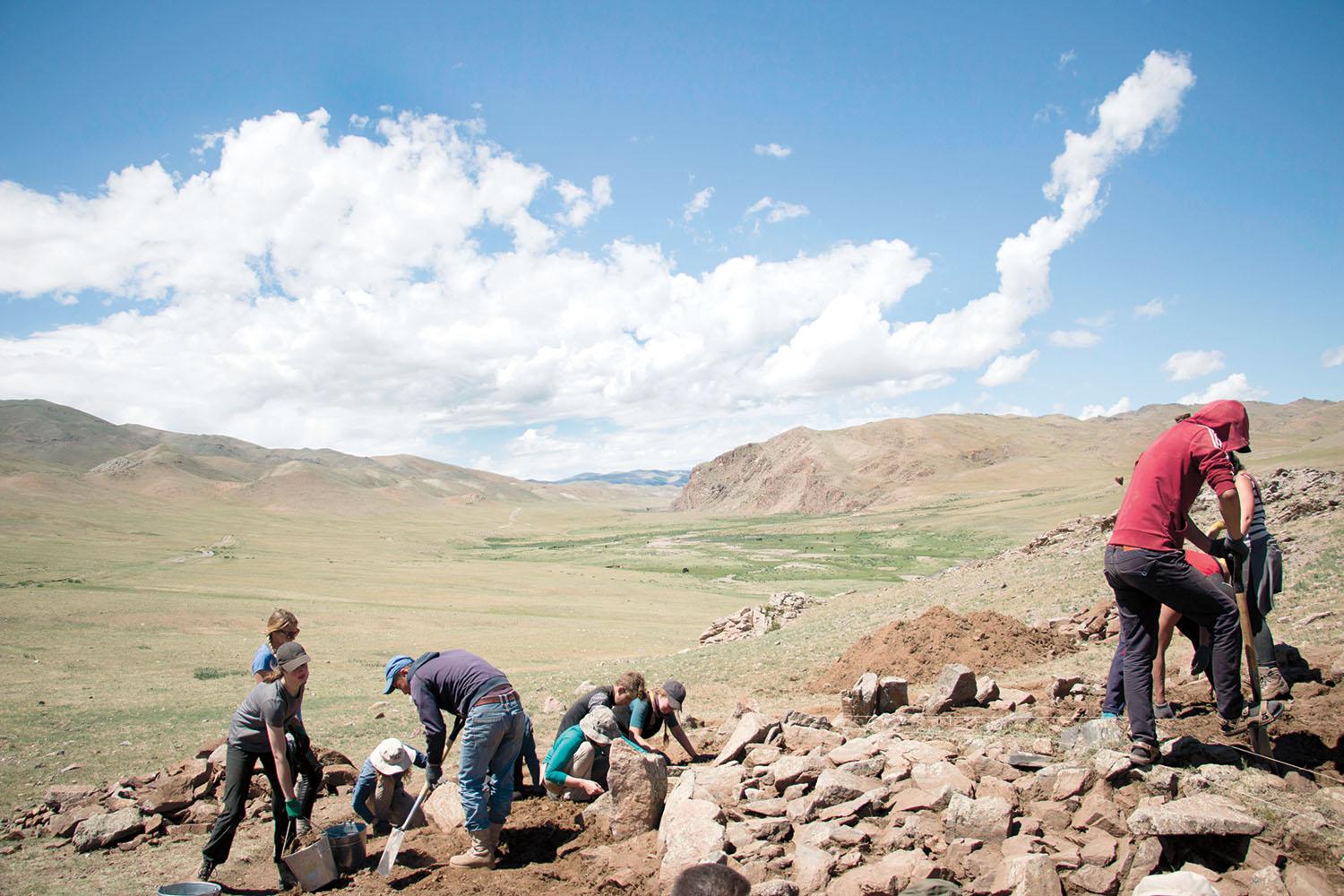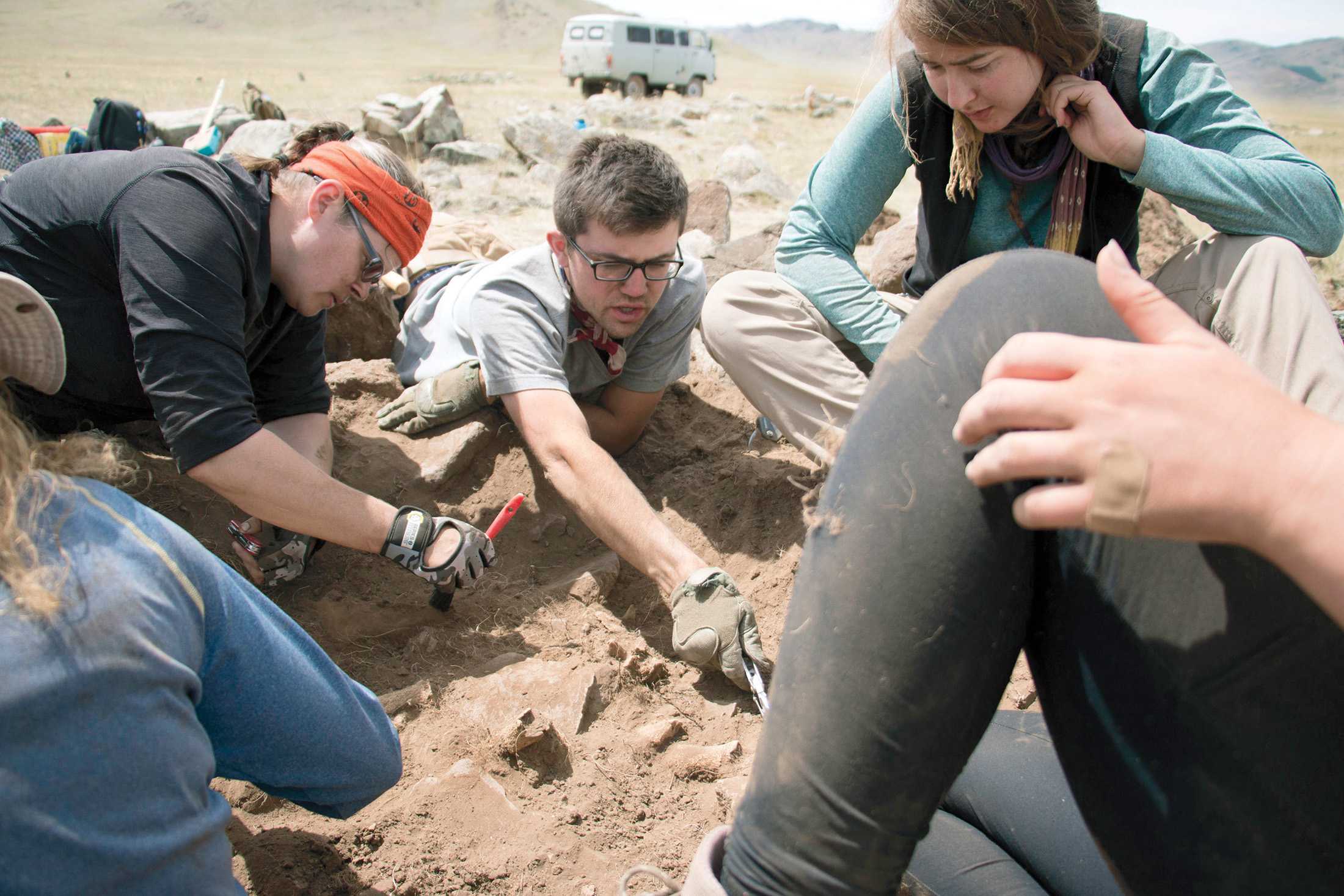This story was originally published in early May in “Grit,” the fourth issue of Talisman magazine.
[dropcap size=big]T[/dropcap]hunder claps, and darkness shrouds the rippling grasslands within minutes.
In the Mongolian steppe, storms blow in quickly with no warning. The team of student archaeologists know only moments remain before a torrent of rain rolls over the mountains and damages the site they’ve carefully excavated, exposing it to the impending elements like an open wound in the earth.
The students shovel quickly, backfilling the void as the wind picks up.
“We’re throwing dirt in there, and the wind is just throwing it right back out,” said Jack Parvin, a student on the team.
The students can’t leave until they fill in the site, but the thick rain makes their jobs harder as it turns the arid dirt into dense mud. As they shovel, the wind whips the mud back at the students.
“It feels like bullets with the high wind, so we’re getting hit with round after round of mud bullets in the face,” Parvin said. “We’re covered from head to toe in dirt.”
Heaving with exertion, the students persevere. Then, just as it had come, the rain ceases and the storm blows off onto distant pastures. Slathered in dirt, the students finish the job, filling in the site to blend in seamlessly with the surrounding landscape, as if nothing had even happened.
Learning from the Land
In summer 2017, Jean-Luc Houle, an associate professor of anthropology, led four WKU students into the remote Züünkhangai region in northwestern Mongolia to participate in his four-week archaeology field school.
As the only archaeologist who works in the region, Houle operates the field school as part of his ongoing research project. He collaborates with Jamsranjav Bayarsaikhan of the National Museum of Mongolia and enlists scientists from various disciplines each year to assist in research.
Houle’s field school started in 2007, and the program offers students the unique opportunity to learn field methods in an archaeologically-rich, under-researched region occupied by one of the last nomadic societies on Earth.
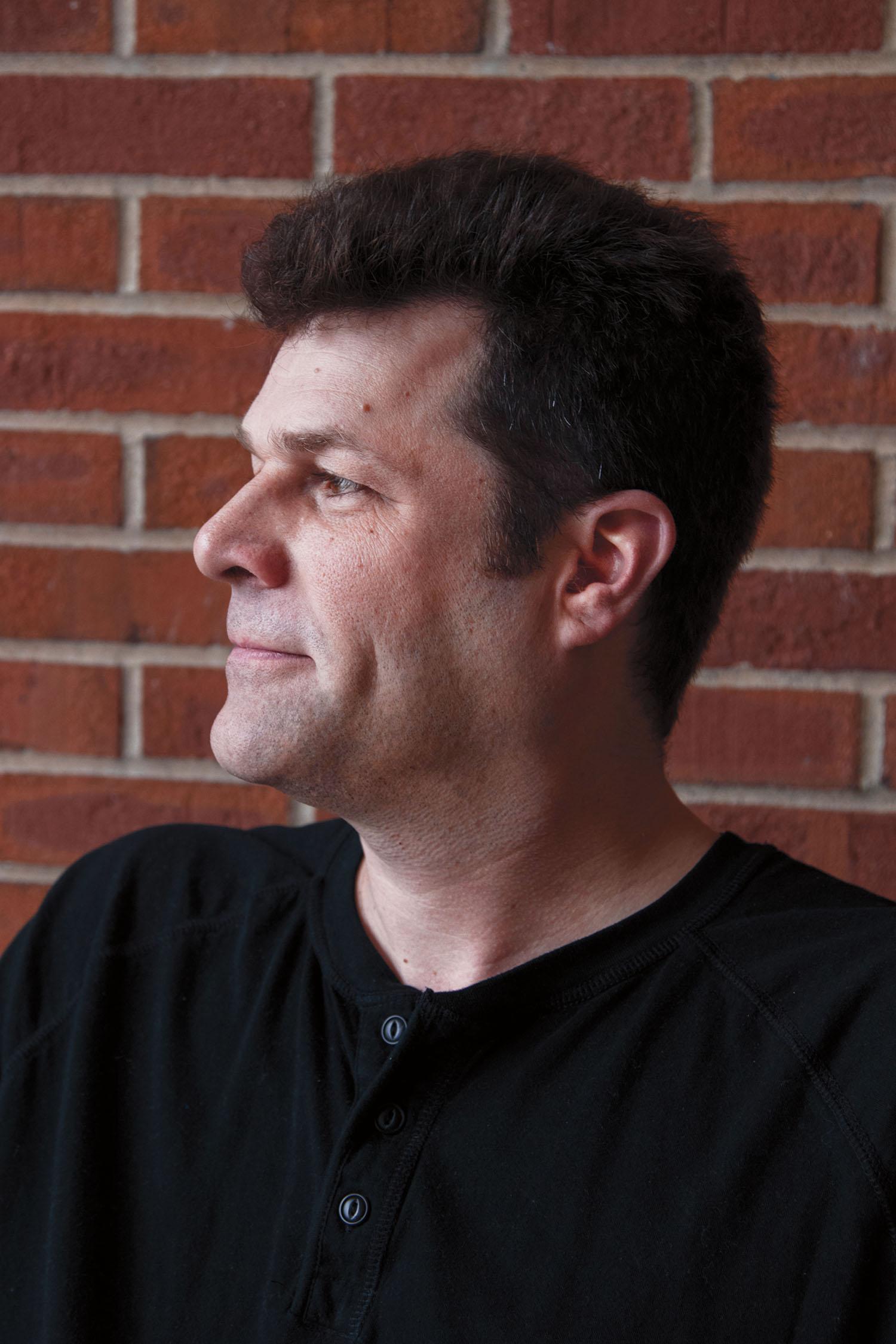
PHOTO BY AUGUST GRAVATTE
Last summer, students helped excavate ritual and habitation sites, survey and locate monuments, and assist specialists in bioarchaeological and geoarchaeological fieldwork.
“I try to give some students different opportunities depending on their interests,” Houle said. “But everybody does everything, and we start early and end late. It’s a lot of work — it’s very intensive work.”
Beyond fulfilling the expectations of the field school, Houle said he hopes the experience provides students with a better understanding of themselves and their abilities.
“What a lot of them realize is they’re more adaptable than they think they are — they’re more able than they think they are,” he said.
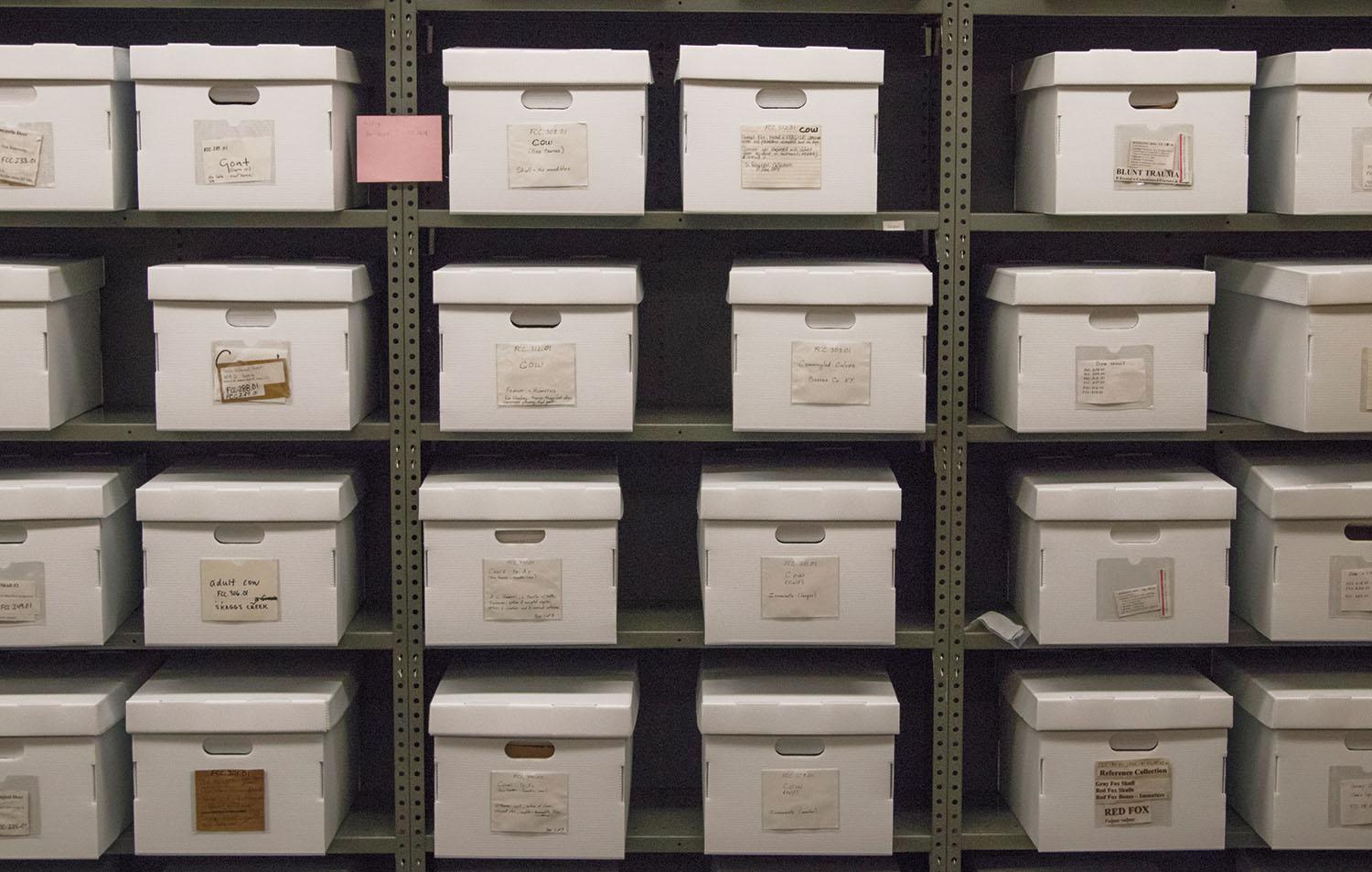
Lessons from the Past
On a rainy afternoon in early February, Houle sat behind his wide desk in a black, button-down shirt and grayish-green pants. He wears a slight variation of this outfit everyday.
His tiny office in the fine arts center is somewhat cluttered and minimally decorated — its main feature is a large bookcase stuffed with book after book about Mongolia.
Houle has devoted the past 16 years of his life to archaeological research in East Asia.
While he was between his master’s and doctorate programs, Houle assisted with a fellow archaeologist’s project in China, where he “fell in love” with the work and the region, he said. Houle later moved his research focus to western Mongolia, and he has worked in northwestern Mongolia for the past two years.
Through landscape and settlement archaeology, Houle seeks to investigate human-environment relationships and establish the nature of the social, political and economic organization of Bronze and Iron Age societies in the Züünkhangai region.
Houle said little work had been conducted in the area before he got there because it’s not considered a core region in more recent history, but some of the oldest archaeological cultures and monuments with domesticated animals’ remains originate there.
“People thought of it as kind of the backwaters, but it’s an area that we’re increasingly thinking might’ve been pretty important in the initial transfers of domestic animals into Mongolia,” he said.
Horses played a central role in Bronze Age societies, and groups constructed thousands of horse head mounds as ritual structures in the region. But Houle is more interested in the trash items uncovered at ancient habitation sites because they convey information about ancient people’s daily routines and the environmental conditions in which they lived.
“They’re not the type of items that you’d put in a museum, but to me they’re answering questions,” he said. “It’s not about the objects; it’s about the story I can tell.”
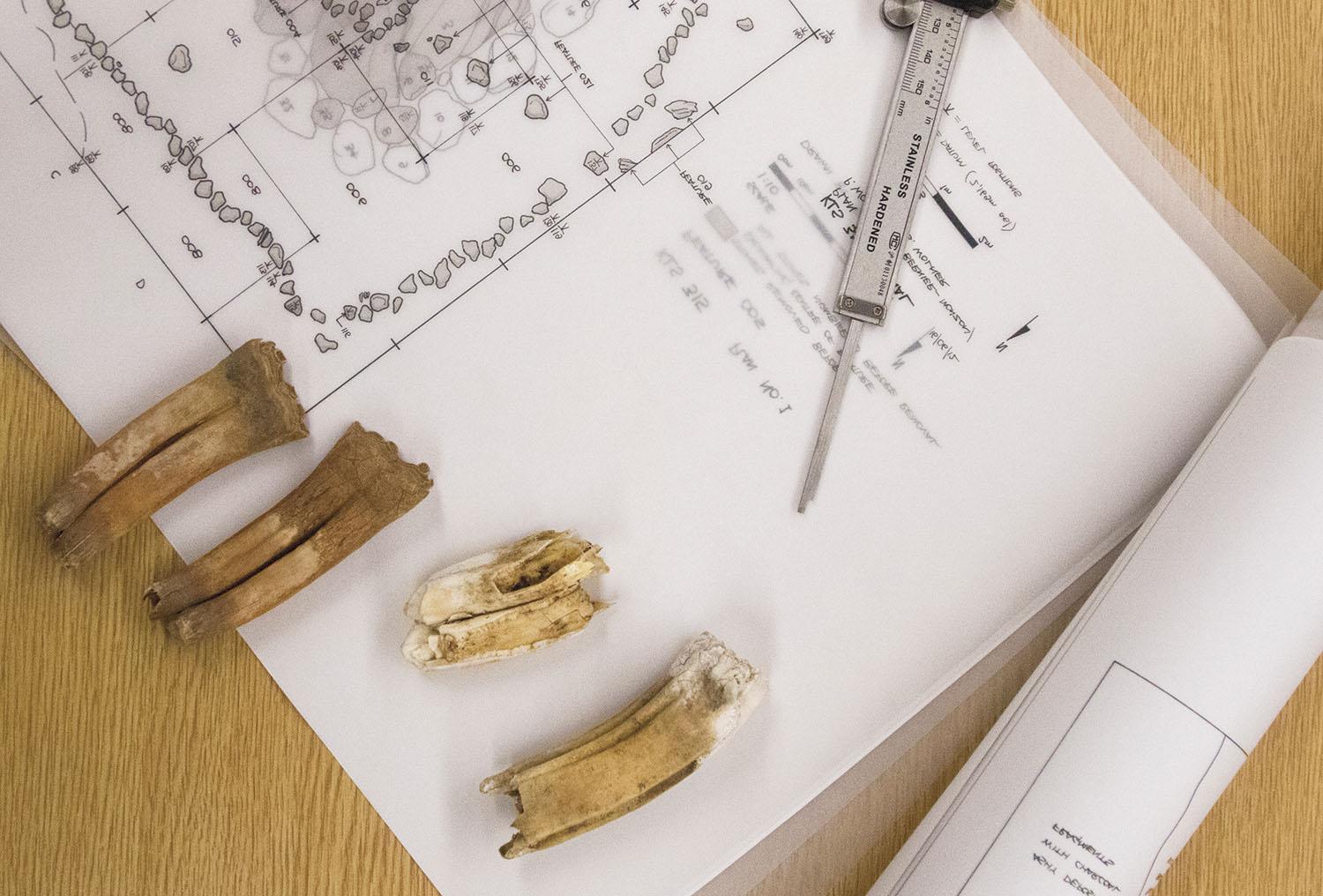
Today, half the population of Mongolia maintains its ancestral lifestyle of nomadic pastoralism, Houle said. Families move two to four times each year in search of new pastures or shelter for their animals. They set up camp in circular “gers,” more commonly known as “yurts,” and they consume mostly meat and milk products.
But climate change increasingly poses a threat to the lifestyle of mobile herders, as global warming affects the region faster than other parts of the world, Houle said. In the past several years, nomads endured prolonged droughts and unusually late winter snowfalls — a phenomenon that decimated 8 to 9 million animals a few years ago, Houle said.
However, the nomads have adapted to climate change in the past, Houle said, and he hopes to learn from the archaeological record to help the population remain sustainable through shifting environmental conditions.
As one of the last nomadic societies on Earth, Houle said the people constitute an important piece of our human diversity.
“If we all become the same, living in cities and eating McDonald’s, the world is going to become a pretty boring place,” he said with a laugh.
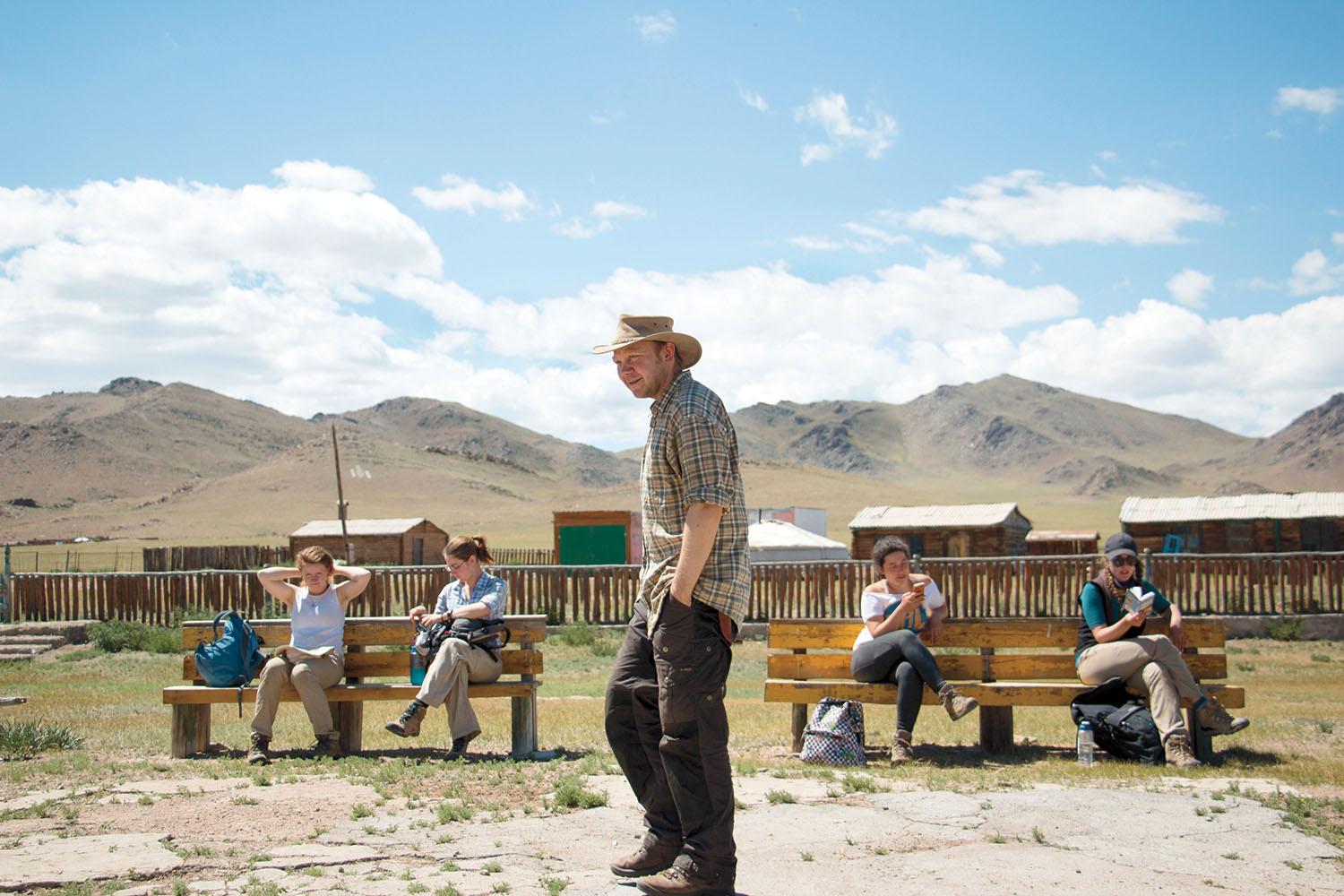
Into the Steppe
After days cramped in airplane seats and delayed in flight terminals, the research team converged in Mongolia’s capital city, Ulaanbaatar, in late May to shop for supplies and prepare for the 4-week expedition in the steppe.
They stuffed daily provisions, like cabbage, potatoes, carrots and rice, into a Russian van, which served the group throughout their time in the field. Ten students from other universities in the U.S. and abroad joined the four WKU students, Houle and his collaborators.
Within minutes of driving west outside the capital, city streets dissolved into grassy countryside, and the dense smog of the metropolis faded into deep, seemingly infinite blueness. During the several-day journey to the research site, the group stopped at various points to rest. They enjoyed a feast at the home of Houle’s Mongolian associate and spent nights at rural truck stops.
Deborah Parrish, a student on the trip, said the truck stops usually consisted of about two gas pumps and a shed. She experienced her first culture shock when she had to use a pit toilet at one of the stops. Two wooden boards rested on each side of a frighteningly deep hole.
“You could easily see down, and it’s a trench at least 30 feet deep, if not more,” she said. “You don’t want to fall in there.”
A Bowling Green resident, Parrish enrolled in the anthropology program at WKU after working in management for nearly a decade. She received her first bachelor’s degree from WKU in 2005 in general studies, but she always wondered about the possibility of returning to school to pursue her strong interest in anthropology.
Parrish decided to take Houle’s Archaeology of China class in 2014 to determine if she truly wanted to take on college while working full time. After the class, she was hooked, and she graduated in December 2017 as an anthropology major with a concentration in bioarchaeology.
Though Parrish was concerned about taking time off work in the busy summer months before her last semester at WKU, she said she felt fortunate her job allowed her to embark on the “once in a lifetime opportunity” the field school offered.
Elizabethtown native Jack Parvin squeezed in the field school before his summer ROTC training at Fort Knox. An anthropology major, he enrolled in the field school after his freshman year because he wanted to try something new.
“Always do something for the sake of saying you’ve done it,” Parvin said. “The experience is worth it.”
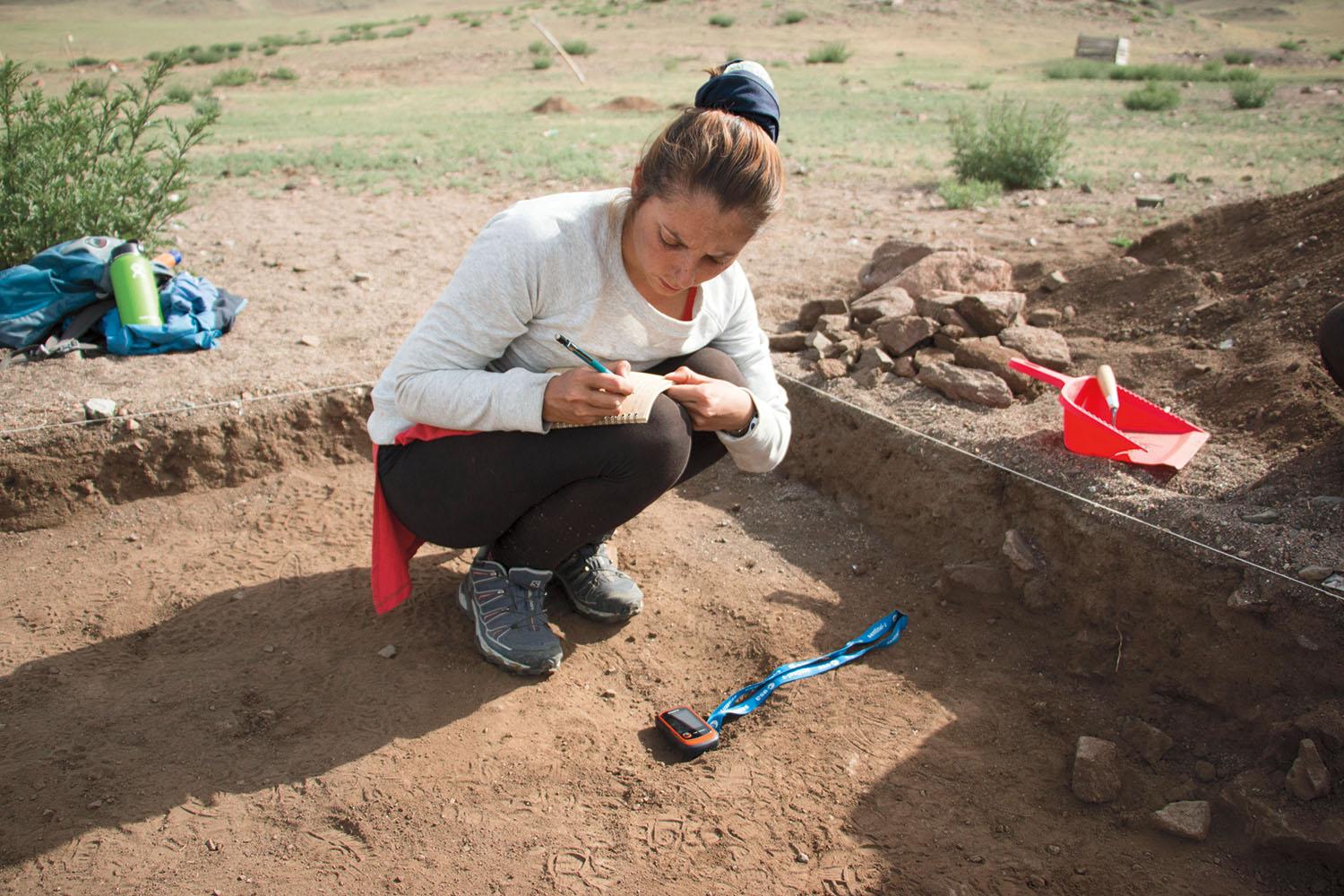
Digging In
In past years, the research team camped out at project sites, but last summer the students and staff stayed in a schoolhouse at a small village.
Parrish said she felt like she had stepped back in time when she encountered poverty in the village, but it ultimately led her to recognize how much Americans indulge and overconsume. She said she noticed how relaxed and happy the villagers seemed, despite the little they owned.
“The pace of everything moves much slower,” she said. “I think that’s why it’s so peaceful.”
Students and researchers woke up with the sun everyday around 5 a.m. Parrish tried to get up a little earlier than everyone else to practice martial arts. She whittled down a couple sticks to use in her forms, and she trained on a small mound facing the village. Each day, she’d watch herds of cattle pass beneath her as the small town animated to the sky’s changing colors.
“It was very peaceful, very awakening,” she said. “I felt my practice was really deep over there.”
Before each expedition, team members pumped and purified enough water to last them the whole day in the field. Without any trees to serve as shade from the hot sun, the team needed to make sure they remained cool and hydrated through the sometimes demanding physical labor.
Parrish said she also used the water to clean off before the van ride back to the village, because she was often caked in dirt after excavating sites. And after a long day of hard work, no refreshing shower awaited the team upon their return to the schoolhouse. Parrish said most students only showered about once a week, so baby wipes proved essential.
The team members spent the first week surveying the steppe, looking for artifacts, landmarks or monuments. One day, Parrish said she walked 11 miles up and down the grassy slopes.
“There were definitely blisters on everyone’s feet after that,” she said.
Parvin said he primarily served as the team’s “shovel bum,” but he didn’t mind digging. He also had some opportunities to work with the bioarchaeologist on skeletal remains and aid in excavating ritual horse head mounds outside large Bronze Age monuments.
Houle said many of the habitation sites are located in exactly the same place as the present-day nomads’ campsites, and some aspects of modern culture retain remnants of ancient practices. For example, when a favorite horse dies, Mongolians will place the horse’s skull on a sacred mountain pointing upward or on top of some of the ancient ritual monuments. Houle said when he started working there in 2001, they were doing so in many cases not knowing that underneath there were also horseheads from 3,000 to 4,000 years ago.
Parvin said the local Mongolians sometimes stopped the research team and asked about what they were doing.
“They would be genuinely interested in their history and their culture because there’s a lot about their own history and culture that’s been lost,” Parvin said.
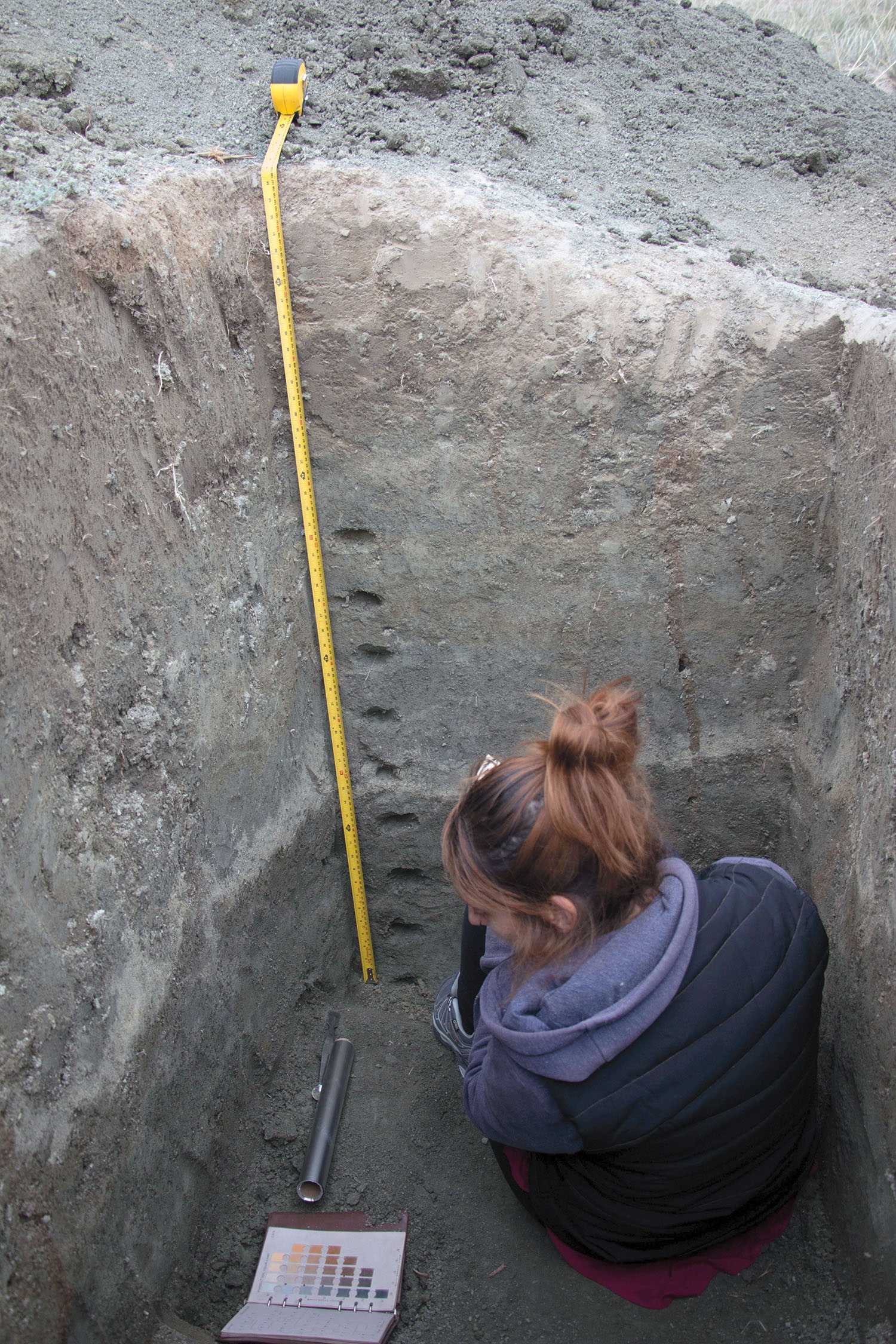
Lasting Discoveries
At the last dig site of the field school, the students unearthed their favorite discovery of the summer: a Xiongnu burial with an amazingly preserved skeleton, a wooden coffin, gold, jade and — most exciting for the group — a perfectly intact pot.
“It sounds weird, but Jean-Luc [Houle] had told us, you’ll never find an intact pot — all pots are broken into sherds and they’re all destroyed,” Parvin said.
But this pot didn’t even have a chip off it — a unique find for a 3,000-year-old artifact.
Despite the mass of uncovered artifacts and data collected over the course of the summer field school, Houle said he has yet to even scratch the surface on the region’s history.
And while he has discovered a completely different culture archaeologically-speaking, the modern-day culture remains one of the most inviting and accommodating in the world, Houle said. He said he’s happy to expose students to the region, in which they also live in their own microcosm of sorts, working alongside students and researchers from all over the world.
Parrish said the group bonded deeply, and she thinks the relationships formed will last a lifetime. She said the rugged lifestyle of working remotely in a foreign place forged the close bonds among the group.
“You have to rely on each other, and it really brings everybody close,” she said. “If you run out of water, you hope that whoever is next to you is willing to share. If you’re drinking vodka with Mongolians, everyone is sharing out of the same cup. If you have problems with someone’s germs, you get over a lot of that superficial stuff. And you just learn we’re all human and we all have the same goals of being happy and wanting to know who we are.”
